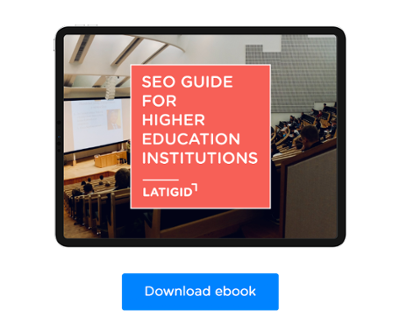
Nowadays, it is no longer necessary to explain to any institution the importance of creating and controlling their online presence, but the truth is that many still continue to use their website as a mere business card.
More than a static digital storefront of an educational institution, a website should be a tool to attract students and create leads that turn into customers.
Follow these 5 steps, adopt an inbound marketing strategy, and turn your institution's website into a real lead generation machine.
1. Optimize your site for search engines
The number of leads generated by your website follows a simple formula:
Leads = website traffic x conversion rate
For your website to be sustainable in the medium-long term, instead of relying on paid advertisement, invest in SEO (Search Engine Optimization) allowing you to be found online and bring in qualified traffic on a continuous basis over time.
To do this, start by analyzing and defining the keywords for which you want to rank. If you have for example a law school, you can start to create content around law.
Here are some of the keywords you could be trying to rank for:
- Law school
- Law degree
- Career in law
- Law program
- Law exam
By creating content around law, you would start bringing prospects to your institution's website. Without traffic, no matter how good your website is, you will never be able to achieve your marketing goals.
2. Blog, blog, blog, and... blog!
A blog is an essential tool for attracting qualified traffic, and websites with a blog tend to have 434% more indexed pages, 97% more inbound links in search engines, and 55% more visits. The blog allows you to write about various topics related to your industry, disseminating content that search engines can index and increasing the probability of being found online.
Use your institution’s social media to increase your blog audience and create content relevant to your target audience, in order to get more social media followers and more links to your website.
3. Offer valuable content
Attracting people to your institution’s website is just the first step. Then, you should be able to convert them into leads, by creating premium content that makes people exchange some of their data for an offer they value (like an ebook, for example).
When creating valuable offers remember that your leads are not all in the same stages of their buyer journey. Some might be 17 years old, finishing high school, and looking for universities to enroll in after high school, others might be 30 and looking for a change in career. And these are not the only cases. There are students who know for a fact that they want to study in your institution and, others, who have no clue what they are going to do and just find universities and degrees as they search online.
Needless to say that institutions that have the best rankings in search engines, the best content, and communicate with / understand their leads are at a crucial advantage over the institutions that don’t have any of this.
As an educational institution, you must focus on creating informative/educational content that helps your prospective students in the various stages they might be in, clarifying their doubts, and making them overcome the barriers they may have in the decision process.
Another way to get prospective students' information is by offering program brochures in exchange for their data. This usually works very well, as students like to have all the information, they need about a program in just one place.
4. Calls-to-Action (CTA)
Calls-to-action are buttons that lead visitors to take any desired action, such as going to a landing page where they can download content, for example.
We can and should test different formats, colors, and texts, to see which ones have the best conversion rates. The CTA text must contain an imperative verb indicating the intended action (“subscribe”, “download”, “click”, “access”, “subscribe”, etc.) what action you will take (download the program brochure or sign up for the law degree webinar, for example).
5. Create Landing Pages with your offer to generate leads
By definition, a landing page is any page on a website where a visitor lands. For us, it is a page that serves exclusively to capture a lead, through a form to obtain data. Since the goal is to keep people on that page and get them to leave their data, landing pages should be as “clean” as possible. Any elements that are not related to this objective, such as navigation bars that can take the visitor away from the page, will only lower the conversion rates.
As you can see, your institution's website can and should be a lead generation tool. For that, you just must start implementing these 5 steps and put them to work for you. If you need help creating a lead generation strategy, talk to us.





